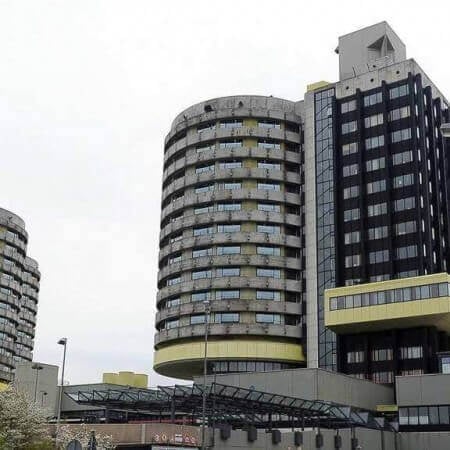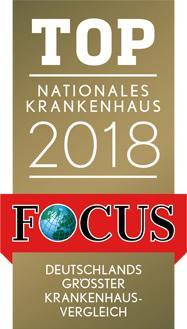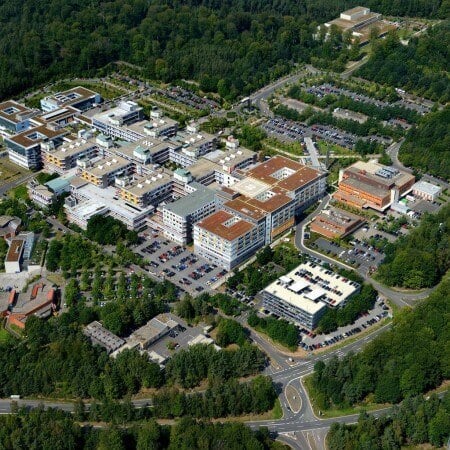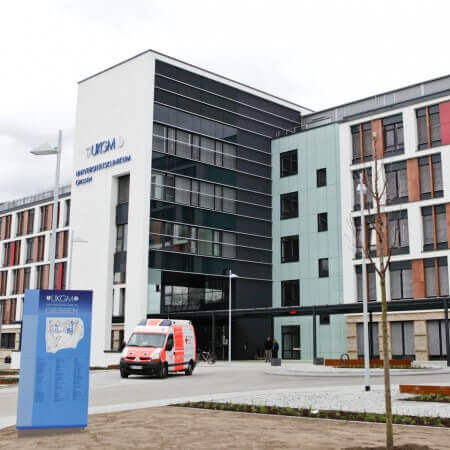Lateral epicondylitis is a fatigue-related injury that occurs in manual workers. It causes pain in the elbow, reduces the ability to work and the quality of life for a patient. Even if this disease torments you for years, you can still get rid of it in just a few weeks. To do this, you just have to go to Germany to take advantage of their latest achievements in the field of orthopedics. German surgeons perform minimally invasive elbow surgery through incisions a few millimeters long. Within a few weeks, you will be able to return to physical work, with a minimal risk of recurrence of the disease, even in the distant future.
Content
- What is lateral tennis elbow?
- Principles of treatment of tennis elbow
- Conservative therapy
- Surgical treatment
- Arthroscopic elbow surgery in Germany
- Why is it worth undergoing treatment in Germany?
What is lateral tennis elbow?
Tennis elbow is the informal name for a fatigue-related injury, it is the most common cause of chronic elbow pain. The medical name for this disease is lateral epicondylitis.
The elbow joint is formed by three bones: the humerus, radius, and ulna. There are two projections in the humerus: the lateral and the medial epicondyles. The tendons of the muscles responsible for the movements of the hand are attached to these protrusions. If these muscles are overloaded, the tendon is permanently injured. These microtraumas are not noticed by a person, but if they are regular, then inflammation develops over time, and pain and degenerative changes in the tendon will progress.
The term epicondylitis means that the place where the tendon attaches to the epicondyle of the humerus is inflamed. This is the result of prolonged micro traumatization. The lateral epicondyle is affected five times more often than the medial one. These patients are diagnosed with tennis elbow. If the medial epicondyle is damaged, golfer's elbow is diagnosed (medial epicondylitis).
Lateral epicondylitis was first described at the end of the 19th century. It was at that time that the condition was given the name tennis elbow, as cases of the disease were reported among people involved in tennis. However, even today, in times of high prevalence of amateur and professional sports, 95% of cases of epicondylitis are associated with professional activities rather than sports activities. The disease affects plasterers, packers, construction workers, and representatives of other specialties who work physically and repeat the same movements for many years in a row.
Principles of treatment of tennis elbow
As a rule, the reason for first visiting a doctor is chronic pain. Many patients believe that it is due to a sports injury or the consequence of a bruised hand. They wait a long time for the pain syndrome to disappear on its own, but it does not, and the intensity of the pain only increases. At the time of treatment, most patients already have degenerative changes in their tendons, and some cannot even bring a cup of coffee to their mouth with their hand being affected by the disease.
The treatment for this disease involves the use of the following methods:
- conservative (drug and non-drug treatment);
- surgical (open and minimally invasive operations).
The preference is given to conservative therapy, with which most patients start their recovery process. The prerequisite for this type of therapy is functional rest for the extremity. If it is not provided, the tendon will not recover, and the disease will recur over time, even after successful therapy.
If conservative treatment does not work or the patient wants to solve the problem of tennis elbow once and for all, doctors perform surgery. They can use either open or minimally invasive interventions. Modern arthroscopic interventions are very sparing, safe, and provide recovery in just a few weeks.
Conservative therapy
Conservative treatment can rarely eliminate the pain syndrome once and for all. As a rule, the patient has to give up his previous job or stop playing sports. Only in this case can we count on a long-term improvement. Conservative therapy is aimed at:
- limiting unwanted movements that injure the tendons;
- reducing pain syndrome;
- relieving inflammatory process;
- regenerating an injured tendon.
Most patients receive nonsteroidal, anti-inflammatory drugs. They relieve pain and inflammation in the elbow.
Non-drug treatments for lateral epicondylitis include:
- cessation of physical labor or limitation of physical activity, refusal to play tennis;
- the use of bandages that block unwanted movements;
- physiotherapy;
- shock wave therapy;
- massage;
- kinesio taping;
- reflexology;
- therapeutic exercises.
If all this does not work, blocks with local anesthetics and glucocorticoids are performed. Doctors perform 2 to 5 injections at intervals of several weeks. This procedure allows for pain relief for a long time, but there is a drawback: glucocorticoids have a negative effect on the condition of the tendon, thereby accelerating degenerative processes. Therefore, doctors try to minimize the number of injections, performing repeated injections only in extreme cases.
To repair the injured tendon, platelet-rich plasma is injected into the elbow. It is prepared from the patient's blood. The doctor puts the blood into a centrifuge. It is divided into two layers: one of them containing erythrocytes and leukocytes, the other containing blood plasma with a high content of platelets. These formed elements of the blood contain the growth factors required for wound healing. Plasma with platelets is injected into the elbow, thus stimulating tissue regeneration. In total, 3-4 injections at intervals of 1 week are required. The therapy is effective in 80% of cases. The effect lasts 6-12 months.
Surgical treatment
A long-term improvement or a complete cure of the disease can only be achieved with the help of elbow surgery. It can be performed on various anatomical structures:
- on the nerves (neurolysis of the posterior interosseous nerve, denervation of the epicondyle);
- on the connective tissue (on tendons and bone tissue).
Nerve surgery is good because it is minimally traumatic and provides recovery in patients in just 1 week. However, these methods are rarely used. They are not radical, which means that they do not cure the disease, but provide only a temporary improvement. The essence of these treatment methods is to reduce pressure on the nerves or to cut the nerves so that they do not conduct pain impulses. These treatments provide good results for the first 6 months, but then the symptoms get worse. For most patients, the problem returns sooner or later.
Connective tissue surgery is a more common treatment for tennis elbow. Most often, doctors perform:
- release (relaxing incisions) of the tendon, weakening muscle traction;
- epicondyle decortication (removal of the upper layer of bone tissue);
- osteoperforation – drilling a hole in the epicondyle.
Surgical procedures can be performed with the use of open, percutaneous (open, minimally invasive), or arthroscopic techniques. The most commonly used are open surgeries. They are technically simpler, do not require special equipment, and have been successfully used since the beginning of the 20th century. Arthroscopic surgeries have been introduced relatively recently. Elbow arthroscopy is a technically complex, but sparing and safe, operation with a short recovery period.
Arthroscopic elbow surgery in Germany
Germany offers developed medicine. Therefore, doctors in German medical clinics often perform elbow surgery using the arthroscopic technique.
These surgical interventions are performed through minimal incisions, using endoscopes with a diameter of 2.4-3 mm. The doctor inserts a mini video camera into the elbow, with the help of which he controls his actions. The intervention is performed with long, thin instruments.
The doctor usually performs a tendon release. Less often, the specialists resort to decortication or osteoperforation of the humerus. These manipulations do not necessarily complement tendon incisions. In recent years, more and more researchers have been inclined to believe that they only cause additional trauma by intervening on bone structures, but do not give better outcomes.
The benefits of sparing arthroscopic surgery options in Germany are as follows:
- full examination of the elbow joint, identification and treatment of concomitant elbow pathology;
- recovery time is 2-4 weeks;
- after 2-3 months, patients can return to lifting maximum loads;
- low risk of complications;
- minimal blood loss;
- comfortable postoperative period without severe pain, with minimal need for analgesics.
After arthroscopy, there is no risk of developing elbow instability. The probability of stiffness is minimal. Since the surgical procedure is performed through short incisions, multiple adhesions and scars do not form in the joint, which would impair elbow mobility or become an additional source of pain.
Why is it worth undergoing treatment in Germany?
Medical clinics in Germany use the very latest conservative and surgical methods for the treatment of tennis elbow. This country can boast a high level of sports medicine and a well-developed healthcare system in general. Clinics receive good funding, so doctors have the most advanced equipment.
Here are several reasons why it is better to receive treatment in German hospitals:
- the use of the most advanced methods of conservative therapy, including cell technologies;
- minimally invasive percutaneous and arthroscopic elbow surgeries;
- low risk of complications;
- speedy recovery;
- full early rehabilitation to prevent elbow stiffness;
- quality care and symptomatic treatment.
Doctors prefer using sparing surgical techniques, after which, patients return to work within a few weeks. The risk of relapse is low, even for those who return to physical labor or high-intensity sports.
To undergo epicondylitis (tennis elbow) treatment in Germany, please use the Booking Health service. On our website you have the opportunity to get up-to-date and accurate information about the cost of treatment in Germany, compare prices in different German hospitals and book a medical care program at a favorable price. The treatment will be easier and quicker for you, and the cost of treatment in Germany will be lower.
You are welcome to leave your request on the Booking Health website. Our employee will contact you, consult with you, and answer all of your questions. We will take care of the organization of your trip abroad. We will provide the following benefits for you:
- We will select the best German hospital, whose doctors specialize in the treatment of tennis elbow lateral epicondylitis and achieve the best results.
- We will help you to overcome the language barrier and establish your communication with the doctor at the German hospital.
- The waiting time for your treatment will be reduced, and you will receive medical care on the most suitable dates for you.
- We will reduce the price. The cost of treatment in Germany will be lower than usual due to the elimination of overpricing and coefficients for foreign patients.
- Our specialists will solve any organizational issues: paperwork, transfers from the airport to the German hospital and back, hotel booking, and interpreting services.
- We will prepare your documents and translate them into English or German. You do not have to repeat any previously performed diagnostic procedures.
- We will stay in contact with the German hospital after the completion of your treatment.
- We will arrange additional diagnostics and treatment, if required.
- We will buy medicines in the other country and forward them to your native country.
While the best specialists in the world are taking care of your health, the Booking Health staff will help you to reduce the cost of treatment in Germany and take care of all your travel arrangements.
Authors:
The article was edited by medical experts, board certified doctors Dr. Vadim Zhiliuk and Dr. Sergey Pashchenko. For the treatment of the conditions referred to in the article, you must consult a doctor; the information in the article is not intended for self-medication!
Sources:
Journal of Orthopaedic Surgery and Research
Articles for Orthopaedic Practice - Orthogate














